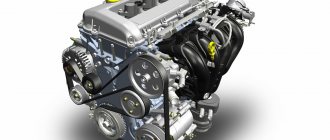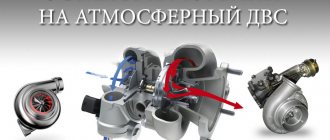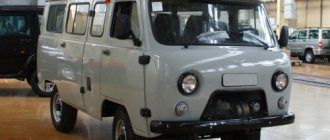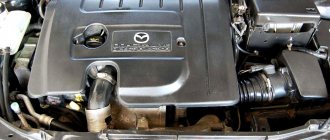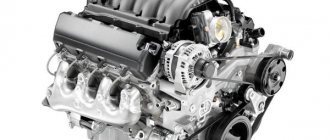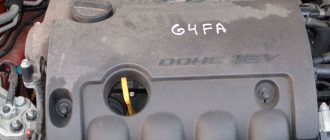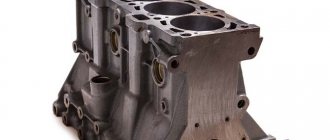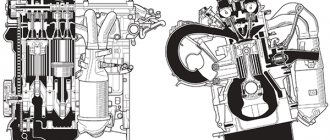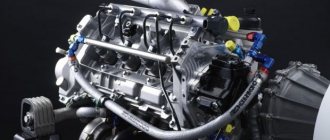Today, in our section on constant dilemmas, we will raise the pressing question of which engine is better to buy - naturally aspirated or turbocharged, and we will talk about the advantages and disadvantages of each of them so that your choice is simpler and more correct.
First of all, it is necessary to understand one important point, the fact is that it is impossible to say unequivocally that a turbine or an aspirated engine is better, both have their “pros” and “cons”. So, let's take it in order...
Advantages and disadvantages of naturally aspirated engine
First of all, for those who are not in the know, I will tell you what an aspirated vehicle is .
An atmospheric engine is usually called a conventional internal combustion engine (ICE), which uses air from a carburetor or injector to form a fuel-air mixture (1 part gasoline to 14 parts air). With the advent of turbo engines, the choice of car became more complicated, as drivers began to be increasingly “tempted” by more powerful turbocharged units, giving them preference over conventional internal combustion engines. However, there are also those who still hesitate to buy a turbine due to lack of knowledge or experience in operating this engine.
Atmospheric power unit
So, before we figure out which engine is better and what the difference is, let’s find out how a classic naturally aspirated engine works. It is an internal combustion engine whose power system is based on a carburetor or distributed injector. The fuel mixture is formed from one part gasoline and fourteen parts air. You can change the proportions depending on need. The ignition system ignites the resulting mixture, and the expanding gas sets the connecting rod and piston group in motion. Due to this, the crankshaft rotates and, as a result, the wheels of the car rotate.
The pressure at which air rushes into the engine is equal to one atmosphere - hence the name atmospheric engine.
There are no means of increasing air pressure here, only natural atmospheric pressure. Now you need to understand the difference between a turbocharged and naturally aspirated engine.
The undoubted advantages of atmospheric engines include:
- Simplicity of design, which has been proven in practice for many decades. Repair and maintenance of such power units cost the owner much less (compared to similar operations for a turbocharged engine).
- Significantly longer service life of uninterrupted operation before major repairs. Under the right operating conditions and proper care, the lifespan of naturally aspirated engines is 2–4 times longer than that of turbocharged engines: 300,000–400,000 km is often not the limit of the “longevity” of such engines.
- Lower oil consumption, which, depending on driving style, usually does not exceed 200÷500 ml per 10,000 km of vehicle mileage. This is due to the absence of additional devices that require lubrication, as well as lower loads experienced by the rotating parts of the motor during operation.
- Unpretentiousness to the quality of the oil used. They work quite satisfactorily on semi-synthetic (and even mineral) motor oils. However, do not forget that the better the oil, the longer the engine life.
- The frequency of oil changes is not as frequent as with turbocharged engines, which must be done after a mileage of 15,000÷20,000 km.
- Less demanding on the quality of the fuel used. As a rule, many naturally aspirated engines can operate quite satisfactorily on AI92 gasoline.
- Faster warm-up in winter.
Pros and cons of naturally aspirated engine
An atmospheric internal combustion engine has a lot of advantages and several disadvantages. The advantages of the engine include:
- unpretentiousness of maintenance - to service the engine, you can use low-quality fuels and lubricants, the main thing is that they are suitable for the engine in their composition;
- multiple repairs - an atmospheric engine can withstand a large number of minor repairs, while the car owner can perform them independently (at home), without necessarily visiting a service station;
- wear resistance - this type is designed for long-term operation (several hundred thousand kilometers);
- maintaining the power level is a key advantage of the product, expressed in maintaining power at low engine speeds, responding to minimal pressure on the accelerator pedal, and transitioning from low to high speeds for a short period of time.
In addition to the positive aspects, this type of motor also has negative aspects. These include:
- weight of the product - naturally aspirated engines, in comparison with other types of engines, are heavier, without having an advantage in volume and power;
- maintaining dynamics and power at the maximum level - in rarefied air conditions, naturally aspirated engines are not able to maintain power at the maximum level, thereby losing the level of dynamics;
- exhaust product - during the operation of an atmospheric engine, a large amount of by-product (exhaust gas) is created, polluting the air masses.
Advantages and disadvantages of a turbocharged engine
the turbocharged engine in 905, and turbines began to be installed on passenger cars only in the middle of the 20th century.
The principle of an engine equipped with a turbine is that the turbine rationally uses the vehicle exhaust, through which additional air is pumped into the cylinders, which promotes better combustion of the fuel-air mixture. As you know, the more air, the better it will burn, a turbo engine is designed on the same principle, a turbine pumps air into the cylinders under high pressure, due to which the combustion of the fuel mixture occurs with greater efficiency, as a result the engine receives at least 10% more power. .
Turbocharged or naturally aspirated engine: choice in favor of the former?
The turbocharged engine first appeared in 1905, and began to be installed in passenger cars in the mid-20th century. The turbine, located inside the engine, uses exhaust gases to create pressure, which is sent to the cylinders to create fuel. Due to the high pressure, more air enters the turbines than that of a competitor, which allows increasing engine power by up to ten percent.
Advantages:
- High power;
- Economical fuel consumption;
- It has a small mass and weight relative to its atmospheric counterpart;
- They can have 2 or 3 cylinders, which allows you to save fuel while maintaining high power;
- More environmentally friendly, as it ensures high-quality combustion of the fuel mixture;
- Excellent dynamics;
- Minimal noise during operation.
Flaws:
- Requires the use of high-quality fuel. Cheap gasoline, which is sold at little-known gas stations, leads to rapid wear of the engine;
- It is also demanding on the quality of oil. Does not accept mineral and semi-synthetic compounds. For this type of engine, you should purchase synthetic oil that is designed for it.
- The motor has a short service life, reaching 120 thousand kilometers, after which it is highly likely that it will need to be replaced. The cost of the procedure is painful for the car owner;
- Slow warming up at low temperatures prevailing in winter;
- An oil change is recommended every 10 thousand kilometers;
- The driver will have to constantly monitor the condition of the filter system. If it is clogged, it will negatively affect the operation of the compressor.
We found out the difference between an atmospheric engine and a turbocharged one.
As you can see, both options have enough pros and cons. If the choice falls on a turbine, the owner will need more attention when caring for it. Such a motor will cost more to maintain than its competitor. Also, do not forget about the special oil, which costs 30-40% more than the composition for an atmospheric engine. An atmospheric engine is inferior in power, but is less expensive to maintain and use.
Many motorists are of the opinion that a turbocharged engine is less reliable, the engine has a complex structure, consumes a lot of expensive oil, warms up the car slowly, so it is better not to mess with it.
Turbocharged engine: advantages
The advantages of turbocharged engines (compared to naturally aspirated analogues) include:
- Higher power (usually 30÷50%) with the same working volume.
- Maximum torque over a wide speed range, which has a very positive effect on the dynamics of the car.
- Less weight and size with the same power. A turbocharged engine is much lighter and more compact than a naturally aspirated one. This allows for the most rational placement of the power unit and reduces the total weight of the vehicle, which, in turn, contributes to fuel economy.
- Fast set of operating speeds due to the lower mass of rotating parts.
- High environmental friendliness, which is achieved due to more complete combustion of fuel in the engine cylinders.
Turbocharged engine: disadvantages
Among the disadvantages of turbocharged engines there are more operational disadvantages. Firstly, an engine with a turbine is more picky about the quality of fuel and engine oil. In addition, on such engines the service life of lubricating and filter elements is much shorter than that of naturally aspirated engines, approximately 1.5-2 times, this is explained by more difficult operating conditions at high temperatures. Owners of turbocharged engines should more carefully monitor the level and condition of filters and oil, and replace them in strict accordance with the engine manufacturer's instructions. The condition of the air filter is equally important; a clogged or damaged filter impairs the performance of the compressor and can cause it to malfunction.
The disadvantages of a turbo engine also include its “gluttony”. A turbine, compared to an aspirated engine of the same volume, will “eat” more fuel.
In addition, a turbo engine has a shorter engine life than a naturally aspirated engine . The turbine wears out over time, especially if the owner does not have the skills to operate such engines. For example, after stopping the car, a turbo engine must be allowed to idle for a while so that the turbine cools down and only then can the engine be turned off.
The cost of repairing a turbocharged engine will be much more expensive than repairing an aspirated engine, and besides, there are not so many people willing to perform this repair; some specialists generally refuse to repair turbo engines. Those who do sometimes carry out repairs poorly, resulting in the engine running intermittently or over time, the turbo engine fails again.
Which is better, a turbocharged or naturally aspirated engine?
An atmospheric power unit is an engine that is not pumped by a turbocharger. It operates on the basis of atmospheric pressure, which is why it got its name. Pistons draw air through filters, after which it is mixed with fuel, creating a combustible composition that ignites.
The advantages of atmospheric air include:
- The difference between an atmospheric engine and a turbocharged one is a simpler operating system and design. Due to this, repair work is cheaper;
- During operation it is not particularly loaded, and then the service life of such an engine is longer than that of a turbocharged one;
- Low oil consumption due to the absence of components requiring lubrication;
- The engine does not require the use of a specific type of oil. Both a mineral mixture and synthetics are suitable here. But don’t forget, the better the quality of this consumable, the greater the chance of the engine to survive without repair for as long as possible. To avoid trouble, you should not skimp on oil;
- The engine is undemanding to fuel quality;
- The oil should be changed every 15,000, maximum 20,000 kilometers traveled. If you do not monitor the composition level, an unpleasant breakdown may occur;
- The difference between a naturally aspirated and a turbocharged engine is the warm-up time. So, the first ones warm up faster.
In addition to a large number of advantages, an aspirated engine also has disadvantages:
- Noticeably inferior to the turbocharged solution in terms of power;
- Greater fuel consumption.
How's the fuel consumption?
If you carefully read about the pros and cons of both engines (aspirated and turbocharged), then you were surprised that we didn’t say anything about fuel consumption. It is worth dwelling on this issue in a little more detail. Let's try to figure out which motor is more economical.
First, let's compare two engines with the same volume (for example, 1.4 liters). An atmospheric engine will consume on average about 6÷7 liters per 100 km, while a trumpet engine will require 8÷9 liters. However, at the same time, it develops a power 1.5 times greater than atmospheric. Conclusion: with the same displacement, the naturally aspirated engine is much more economical (after all, it not only “eats” less fuel, but also uses cheaper gasoline), but is significantly inferior to the turbocharged engine in terms of power.
Now let’s compare the fuel consumption of engines with the same power (for example, about 140÷150 hp). So many “horses” under the hood usually have a 2.0-liter naturally-aspirated engine or a 1.4-liter turbocharged engine. In the urban cycle, the consumption of a conventional engine will be about 12÷14 liters per 100 km, while that of a turbocharged engine will be the same 8÷9 liters. Conclusion: even taking into account the lower cost of gasoline required for normal operation of an atmospheric engine, a turbocharged engine is much more economical.
As you can see, both engines have their pros and cons; in order to understand which engine is better - turbocharged or naturally aspirated , you need to understand for yourself the priority aspects of a particular unit.
